cross country
I recently completed a two-month trip across the country. There were two legs of the journey and I took lots of photos on both of them. The first part, from Brooklyn to Chicago by car, took place at the start of the summer. The second part, from Chicago to the Bay Area by plane, took place at the end. Each leg provided a distinct perspective on the American landscape and I had a window seat for both.
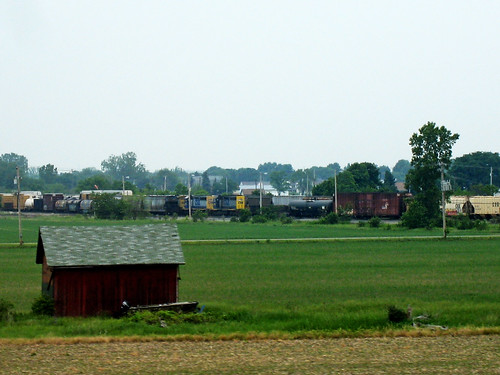 Freight train, Ohio.
Freight train, Ohio.
From the car, I saw a thin slice of the country, but from quite close. In addition to hearing the horns of freight trains, I could also smell the chicken coops. (It makes you wonder what they do in there...)
From the airplane, I saw a broad swath of the country from a great distance. On the one hand, I could really appreciate the geography of the American West. (I was particularly drawn to its dams and reservoirs.) On the other hand, I didn't get to go to any of the places I saw.
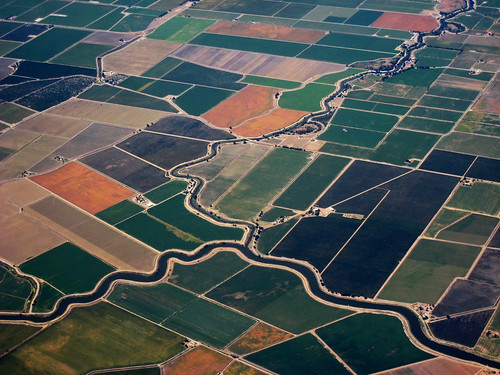 Farmland, California.
Farmland, California.
On both segments of the trip I saw farms. There are, I learned, lots of different kinds of farms.
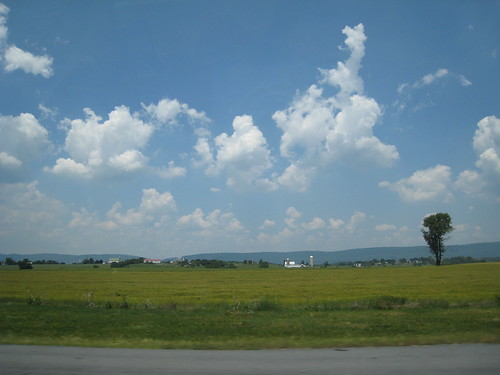 Farmland, Pennsylvania.
Farmland, Pennsylvania.
Some farms are center pivot irrigated -- watered by sprinklers that rotate around a central point. From the ground, these sprinklers look a bit a like a suspension bridge, fork-lift, and garden hose all rolled into one device.
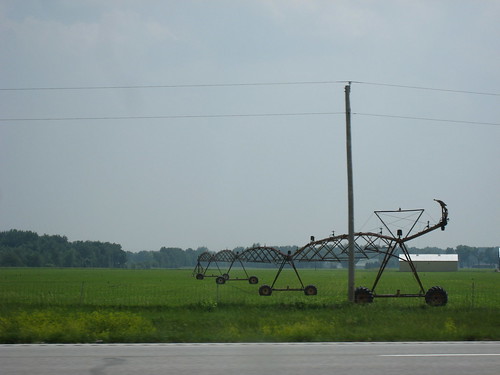 Center pivot irrigation sprinkler, Ohio.
Center pivot irrigation sprinkler, Ohio.
The true beauty of center pivot irrigation, however, is only visible from above. By virtue of their radial design, farms using the system have crops arrayed into circles. Sometimes the countryside looks like it's covered in pie-charts.
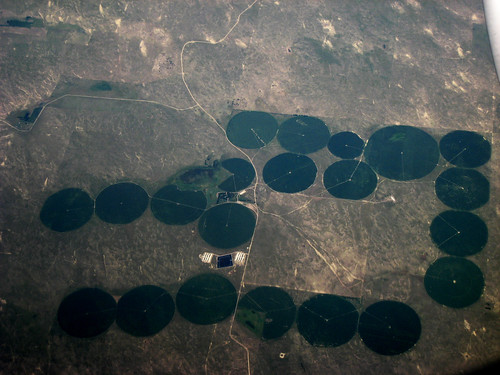 Center pivot irrigated farms, Southwestern US. (Central pivot irrigation has been used to grow crops in the Sahara!)
Center pivot irrigated farms, Southwestern US. (Central pivot irrigation has been used to grow crops in the Sahara!)
Another kind of 'farm' I saw didn't grow anything at all: it produced power.
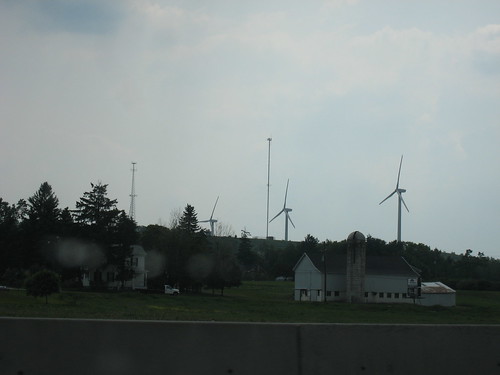 Wind farm, Pennsylvania.
Wind farm, Pennsylvania.
The first wind farm I saw was in western Pennsylvania. The towering three-bladed turbines were a striking juxtaposition to the traditional dairy farms on the ground. Nonetheless, windmills seemed like a good fit in Amish Country.
On the approach to Oakland Airport, I got another look at a wind farm when my plane flew over Altamont Pass. Constructed in response to the 1970s energy crisis, the Altamont Pass Wind Farm was once the largest in the world. From above, it's almost impossible to see the propeller blades move; instead of looking like power plants, the turbine arrays look like battalions of toy soldiers. (Fighting for the environment, of course.)
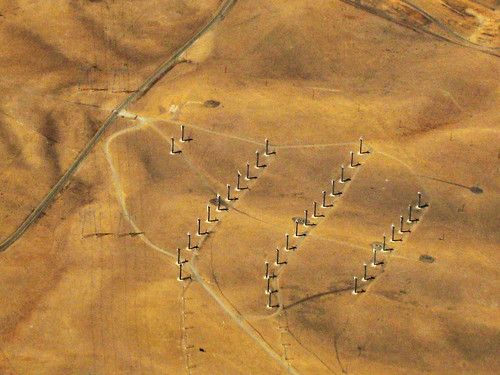 Altamont Pass Wind Farm, California.
Altamont Pass Wind Farm, California.
Despite enjoying the journey west -- as well as the two month layover in Chicago -- I'm glad it's over. It's nice to be finally be here in California.
 Freight train, Ohio.
Freight train, Ohio.From the car, I saw a thin slice of the country, but from quite close. In addition to hearing the horns of freight trains, I could also smell the chicken coops. (It makes you wonder what they do in there...)
From the airplane, I saw a broad swath of the country from a great distance. On the one hand, I could really appreciate the geography of the American West. (I was particularly drawn to its dams and reservoirs.) On the other hand, I didn't get to go to any of the places I saw.
 Farmland, California.
Farmland, California.On both segments of the trip I saw farms. There are, I learned, lots of different kinds of farms.
 Farmland, Pennsylvania.
Farmland, Pennsylvania.Some farms are center pivot irrigated -- watered by sprinklers that rotate around a central point. From the ground, these sprinklers look a bit a like a suspension bridge, fork-lift, and garden hose all rolled into one device.
 Center pivot irrigation sprinkler, Ohio.
Center pivot irrigation sprinkler, Ohio.The true beauty of center pivot irrigation, however, is only visible from above. By virtue of their radial design, farms using the system have crops arrayed into circles. Sometimes the countryside looks like it's covered in pie-charts.
 Center pivot irrigated farms, Southwestern US. (Central pivot irrigation has been used to grow crops in the Sahara!)
Center pivot irrigated farms, Southwestern US. (Central pivot irrigation has been used to grow crops in the Sahara!)Another kind of 'farm' I saw didn't grow anything at all: it produced power.
 Wind farm, Pennsylvania.
Wind farm, Pennsylvania.The first wind farm I saw was in western Pennsylvania. The towering three-bladed turbines were a striking juxtaposition to the traditional dairy farms on the ground. Nonetheless, windmills seemed like a good fit in Amish Country.
On the approach to Oakland Airport, I got another look at a wind farm when my plane flew over Altamont Pass. Constructed in response to the 1970s energy crisis, the Altamont Pass Wind Farm was once the largest in the world. From above, it's almost impossible to see the propeller blades move; instead of looking like power plants, the turbine arrays look like battalions of toy soldiers. (Fighting for the environment, of course.)
 Altamont Pass Wind Farm, California.
Altamont Pass Wind Farm, California.Despite enjoying the journey west -- as well as the two month layover in Chicago -- I'm glad it's over. It's nice to be finally be here in California.

No comments:
Post a Comment